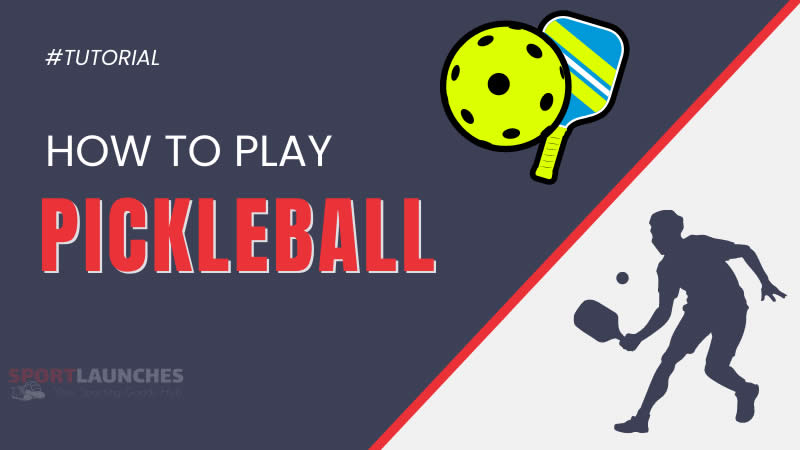
How to play pickleball for beginners
The pickleball court has the same size as a badminton court. It is a rectangular area that measures 20 feet wide and 44 feet long. The court is divided into halves by a net that is suspended 36 inches high in the center.
It also has a non-volley zone or kitchen area, a right-service court, a left-service court, a centerline, sidelines, and baselines.
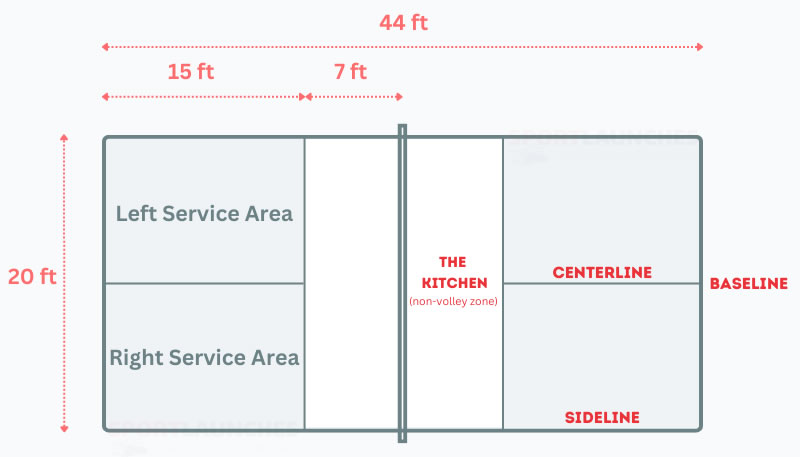
Pickleball can be played as a doubles or singles game.
A pickleball doubles game is played with four persons, with two persons on each side of the court. The pickleball singles game is played with two persons, with one person on each side of the court.
If you have four players, you can play a doubles game where there are two players on each side of the court. Alternatively, if you only have two players, you can play a singles game.
The USA Pickleball Association Rulebook states that “any fair method can be used to determine which player or team has first choice of side, service, or receive.“.
Here are some suggestions I have for you:
- Coin toss: it is a simple and easy method to determine which team serves first in pickleball. Each team calls heads or tails, and a coin is flipped. The winner then decides whether their team will serve or receive the ball first.
- Rock-paper-scissors: Another way to decide is to play rock-paper-scissors. It is also fun!
- Spin the paddle: You can mark one side of the paddle as ‘serve’ and the other side as ‘receive. Spin the paddle. The side that faces up after the spin determines which team serves first.
Let’s see how to serve in pickleball.
The first serve of the game is always done by the right-side player, regardless of whether it is a singles or doubles game.
The player must serve from behind the baseline of the court, and the serve must be an underhand strike where the serving hand does not go above the waist level.
Players have the option of hitting the ball out of the air, which is the more popular method, or dropping it on the ground and hitting it.
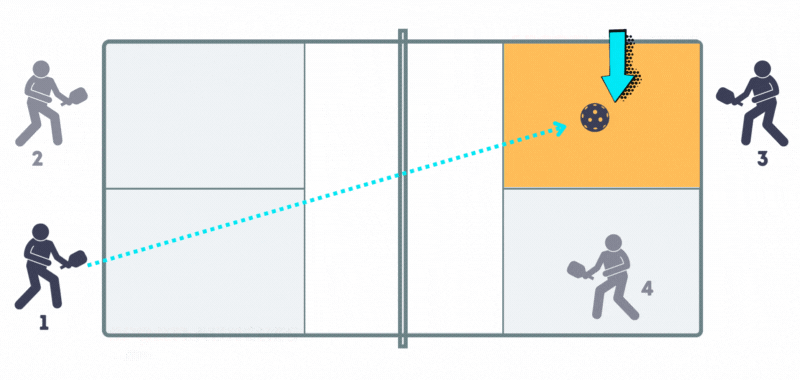
It means that the player receiving the serve must let the ball bounce once before hitting it, and the player receiving the return must also let the ball bounce once before hitting it again.
In essence, the rule states that the first two shots of a rally, including the serve and return, must bounce on each side of the court before a player can hit the ball.
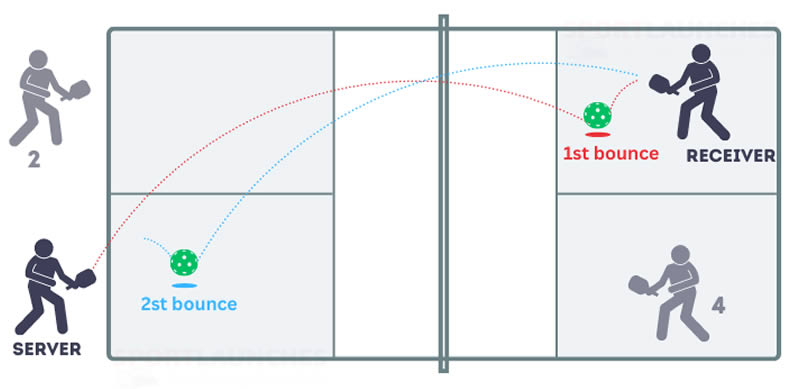
- Off the bounce, also known as groundstrokes.
Groundstockes in pickleball are the shots that are hit after the ball has bounced once on the ground. These shots are made from the back of the court or baseline.
- Out of the air or volley.
Volley shots are the ones where the ball is in the air without allowing it to bounce on the court. Volley shots are commonly used at the net, where players may hit the ball back and forth in a fast-paced rhythm.
I recommend you familiarize yourself with both types of shots. Mastering both techniques can help you improve your skills.
Players continue to hit the pickleball back and forth until a fault is committed.
There are five main types of fault in pickleball according to the USA Pickleball rulebook: the shot lands out, the ball is hit before bouncing on the ground (two bounce rule), the shot hits the net, the ball bounces twice on the ground, and the serve lands in the non-volley area.
Let’s also take some examples:
- A player does not respect the “Two-Bounce rule” and hits the pickleball before it has bounced
- A player hits the pickleball into the net
- A player hits the ball twice in a row
- A player touches the net with their body
- A player hits the pickleball from inside the non-volley area of the pickleball court
- A player hits the pickleball from outside the pickleball court
- A player hits the pickleball and it lands out of the pickleball court
The shots and serves in pickleball can be either in or out. As they are different from each other, I will explain them separately.
-
Pickleball shots:
- All shots that land in the court or directly on the lines, even on the non-volley area lines” are considered “in”.
- All shots that land outside the court are considered “out”
- If the serve lands in the non-volley area, on the lines of the non-volley area, or outside the court it is considered “out”.
- If the serve does not land outside the court, in the non-valley area, or on the lines of the non-volley area, then it is “in”.
Pickleball serves:
In pickleball, all players are responsible for calling out “out” balls by shouting loudly and indicating the location where the ball landed.
If you see an out ball, make sure to shout it out loud and clearly indicate where it landed on the court.
This means that the serving team always has the opportunity to score points, while the receiving team can only score when they win the serve and the rally.
Why is it designed this way? This rule ensures that all players get a chance to serve at least once in a game. Additionally, it encourages aggressive serving and rewards teams who can consistently win points off their serve.
So, as you play, remember that the serving team has the advantage to score more points and maintain their lead.
However, if the score becomes tied at 10-10, the game continues until one team has a two-point lead. This means that the game can continue until a score of 15 or 21, depending on the players’ preference.
Example: For instance, if the score is 10-10, the game may continue until one team scores 12 or 13 points, or until one team wins with a score of 15 or 21. So, the players have to keep playing until one team wins by a two-point lead.
How to play pickleball doubles
Let’s start by seeing how to play pickleball with four players. This pickleball format is more popular than the two-person version.
Players must agree on a fair method to determine which team serves first.
Once the players agree on a fair method, they can determine which team serves first.
In pickleball doubles, both teams should position themselves on opposite sides of the court. On each part of the court, there is a right-hand side for one player and a left-hand court for the second player of each team.
When starting the game, the team that serves should be positioned in the right-hand court on their side of the court.
The team that receives should be positioned on the opposite court, with one player on the right-hand court and one player on the left-hand court.
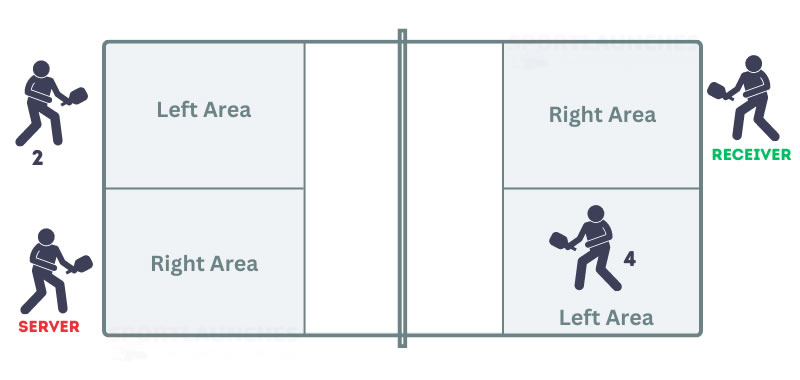
I know it may seem confusing at first, but let me explain.
Every time you serve, you must shout out three numbers, which represent the current score and serving order.
For example, 3-4-1 means the serving team has a score of three, the receiving team has a score of four, and it is the first serve. Or in other words is always your score, your opponent’s score, and your serve position.
Now, you might be wondering who should call out 3-4-1 and who should shout 3-4-2. The player standing on the right side of the court when the side out occurs is designated as the number 1 player (“the one”) and should call out 3-4-1. Once the serve is lost it moves to the other partner that must shout 3-4-2 (“the two”).
It’s important to note that there is one exception to this rule. The first player to serve in the game calls out “0-0-2” so that the starting team only gets one serve.
In order to understand what to do when a fault takes place, it’s important to know that there are three different scenarios that determine how the next rally will start.
Let’s take a closer look at each of them.
- if the serving team wins the rally, the team earns a point and continues to serve. The players of the serving team switch sides of the court, and the same server serves from the opposite side of the court.
- if the serving team loses the rally, then no point is awarded. The players of the serving team stay in the same place, and the serve goes to the next player of the serving team.
Keep in mind that if your team as a serving team loses the point, the serve won’t switch to the other team. Instead, it will move to your partner, who will announce “3-2-2” before serving. That is the best at pickleball. Each pickleball player can contribute and serve in a game.
- if the serving team loses again, the ball goes to the other team, and it’s called a side out. At this point, the players do not switch sides, and the player on the right side of the court of the opposing team becomes the new server.
How to play pickleball singles
Can you play pickleball singles? Yes, you can!
Pickleball singles is just as fun and thrilling as doubles, and it’s actually a variation of the sport that shares similarities with doubles while also having its own unique aspects.
The beginning of a pickleball singles game follows the same steps as doubles. The two players must choose who starts the game, and then the two-bounce rule applies.
However, playing pickleball singles involves some key differences that are specific to this version of the sport, such as the need for players to cover the entire court alone. This requires a different set of skills and strategies compared to doubles play.
Let’s see exactly what are its distinctive features.
Each of the two players will serve on the side of the court based on their score. It may seem complicated, but it’s really not.
What does this mean?
In pickleball singles, the serving player must serve from the right side of the court if they have an even score, such as 0, 2, 4, 6, 8, or 10 points.
The ball must land on the right side of the opponent’s court. On the other hand, if the serving player has an odd score, such as 1, 3, 5, 7, or 9 points, they must serve from the left side of the court and aim for the receiver’s odd/left-hand side of the pickleball court.
In simple words, the right side is for even scores and the left side is for odd scores.
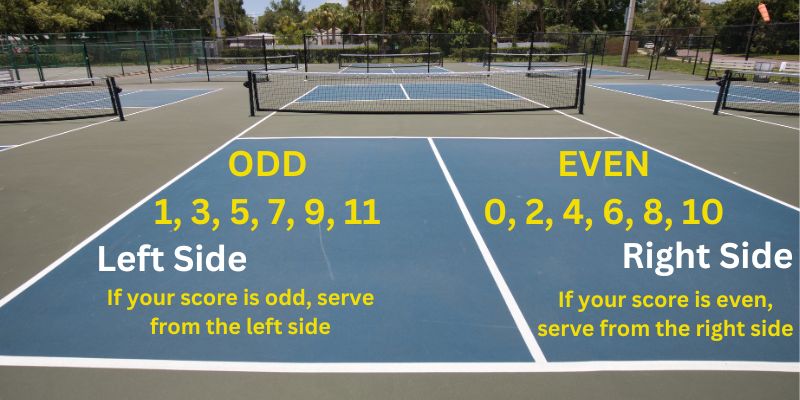
Easy, right?
As each player is alone on the court, they must cover the entire area. This also means that if you’re serving and lose the rally, the ball goes directly to your opponent on the other side.
Instead, they only need to call out two numbers – their own score and their opponent’s score. This helps to avoid confusion and keep the game flowing smoothly.
So if it’s your turn to serve, simply shout out the scores and you’re good to go.
- The game starts with a serve from the right side of the court, and the player must stand behind the baseline and serve diagonally.
- The two-bounce rule applies, meaning the ball must bounce once on each side of the court before players can hit the ball in the air.
- After the serve and return following the two-bounce rule, the rally continues until one of the players commits a fault, such as hitting the ball out of bounds or into the net.
- If the server wins the rally, they earn a point and switch sides of the court to serve from the other side.
- If the receiver wins the rally, they do not earn any points, but they become the new server for the next point.
- The game is played until one of the players reaches 11 points with a two-point lead, and that player wins the game.
How to play skinny singles pickleball
Skinny singles pickleball is a simplified version of singles pickleball.
Like singles pickleball, it is played with two players, and most of the rules from doubles and singles apply to skinny singles pickleball.
However, in skinny singles, only one-half of the court is used, which is the one that the serve is hit from.
So, how do you play skinny singles?
- Like singles pickleball, you need two players for skinny singles.
- Find a method to decide who will serve first.
Now, here is something that makes skinny singles special. Players must play using only one-half of the court.
However, there are two variations to choose from:
- cross-court: This means that serving and returning are played diagonally across the court.
- down the line: In this case, serving and returning are only on one half of the court.
Let’s take an example to understand better:
- The first server begins serving from the right side (even side) at a score of 0-0.
- The serve is hit by the player cross-court into the opponent’s right side.
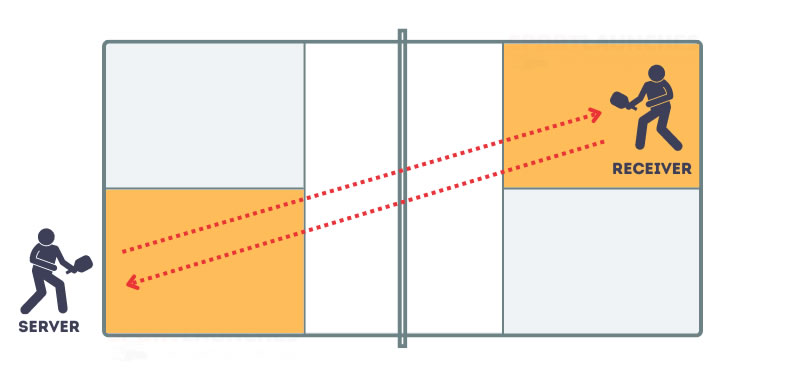
- After the serve, all the other shots in skinny singles must be hit cross-court until the rally is ended by a player committing a fault.
- If the server wins the rally, the server moves to the left side (odd side) of the court. The receiver stays in the same place. Only a server who wins the rally moves in skinny singles.
- Now all shots are hit down the line only on one half of the court.
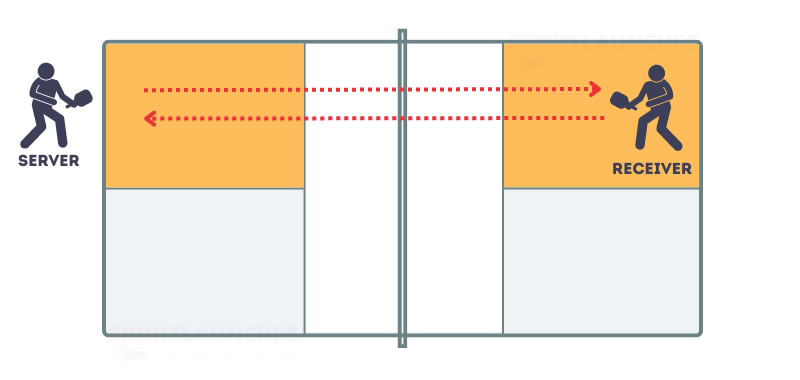
- If the server loses the rally, nobody moves, and the game continues with cross-court shots.
All other steps like the two-bounce rule, faults, or the end game with 11 points are exactly as in doubles and singles pickleball.
Strategies and Tips
For those who are considering playing pickleball but would like to learn some effective pickleball strategies, tips, and techniques beforehand, I’ve got you covered.
Below, you’ll find a range of tips and strategies to help you win in both pickleball doubles and singles, as well as some helpful advice for beginners.
Check them out.
Pickleball Strategies and Tips for Beginners
Here are some simple tips on how to play pickleball for beginners:
- The player that serves stays put, while the player that returns runs to the net. The server needs to keep their position to hit the big return, while the player that returns needs to go to the kitchen line to be in defense.
- Make your way to the kitchen line. You are most in control of the game when you’re playing from the non-volley area. If you stay in the back, you’ll have a hard time scoring and defending yourself from the other players’ shots.
- Maintain some space between you and the kitchen line. Always try to step back a bit from the kitchen line because if you are out of balance, you do not want to step on that line. You can always ask your teammate for help when you feel like you are going down.
- Mix up your shots and stay unpredictable. Always alternate your shots and try to surprise your opponents.
- Always keep your paddle up to block all shots. Be prepared and ready to hit that ball. Do not keep your hands down. You want them up and ready for action to block that ball instantly. This is also a great strategy for beginners playing pickleball. Remember, you do not need to score all the time; it is sufficient to just block the ball and not let the opponent win the rally.
- Practice dink shots. Dink shots can be used to slow down the pace of the game, disrupt the opponent’s rhythm, and force them to move closer to the net.
Pickleball Strategies and Tips for Doubles
1. Serve and hold your ground
When you are serving in a game, you have to make a powerful, deep serve that lands diagonally in the opponent’s court. You also need to hold your ground and be ready for the return the opponent team throws back at you.
Why, you ask? If you serve and step towards the non-volley area, you’ll be caught off guard when the opponent sends a deep return your way. You’ll be out of balance and might even have to backtrack just to catch the ball. The changes to score when you try to regain your balance are small.
On the other hand, if you stay in the starting position, you’ll have a much better chance of catching that big return.
2. Return and run to the non-volley area/ kitchen
This strategy makes you more dangerous and puts more pressure on the opposing team. When you’re receiving the ball, you want to start at the back of the court, so you can return any deep shots that come your way.
But that’s just the beginning. After hitting the ball back, you have a choice to make: stay put or move toward the net.
What do you do? You run to the kitchen line! If you stay in the same spot, you’re not a challenge for your opponents.
Just run like the wind towards the net. Once you’re in the non-volley area, you’re becoming a real adversary for the other team, able to block their angles and shots.
So, remember to return with a big hit and just run toward the net!
3. Learn how to make great shots
Here’s the deal: after you make a big return and run up to the kitchen line, you need to be able to make great shots in order to score points.
To do that, you need to have proper posture and know how to hit the ball effectively.
Having good posture is crucial for maintaining balance and moving quickly on the court. Keep your legs slightly bent and your hands up and active, instead of just standing straight up. Keeping your paddle up allows you to block the ball immediately and be prepared for any shot that comes your way.
In addition to posture, it’s important to keep your swings short and compact. Avoid big, exaggerated swings as they increase the chance of hitting the ball into the net. Instead, focus on using a quick and controlled motion to hit the ball with precision.
4. Use tactics for the third shot
In pickleball, there is the serve or shot number one, the return or shot number two, and the shot number three.
For shot number three, there are two tactics you can use to stress and put pressure on your opponent:
- drive the ball
- drop the ball
Drive the ball
Let’s begin with the driving tactic.
You want to drive the ball at the player who returns the shot after serving. Why?
Because that player will run toward the kitchen line right before returning the serve. The player will have a difficult time hitting the ball while on the move toward the net.
Drop the ball
The second tactic you can apply is the drop shot. But where should you drop the ball? You want to aim for the middle of the other team’s court. That area is open, and both players will have a hard time reaching it.
Additionally, by dropping the ball in the middle, you minimize the risk of hitting the ball out of bounds.
5. Play to your strengths and your opponent’s weaknesses
Always try to use your strengths in the game and identify your opponent’s weaknesses.
Let’s see some specific examples:
- If your opponent has a strong forehand but a weak backhand, aim your shots at their backhand.
- If your opponent excels at dinking, try to avoid dink rallies.
- If your opponent has low mobility, try to hit the ball in various directions on the court and make them move more.
Observe your opponent and you’ll have an upper hand in the game.
6. Hit at the opponent’s feet
This pickleball strategy is to hit the ball at your opponent’s feet, also known as the “dink to the feet” strategy.
To execute it, you need to hit the ball softly and low, which makes it difficult for your opponents to return the ball.
When the ball lands close to players’ feet, your opponents have to make a quick move to return it, potentially leading to a mistake.
Also, this makes it harder for them to return it since they have to hit the ball from a lower position. However, it’s important to mix up your shots and not rely solely on hitting the ball to their feet.
Pickleball Strategies and Tips for Singles
1. Serve big
Starting with a strong, deep serve is a technique that can give you an advantage over your opponent in pickleball singles.
Why?
Your main goal in pickleball singles is to keep your opponent away from the net since you do not have a doubles partner to cover that area. As you are the only player on your side of the court, you need to be able to cover both the back and front area.
By serving big, you can force your opponent to move farther back and make it easier for you to defend both areas of the court.
2. Serve near the “T”
When serving in pickleball, your aim should be to hit the ball near the “T” of the court.
The “T” refers to the area where the centerline and baseline intersect, which is the middle of the pickleball court.
By doing so, you can gain more time to prepare for your next shots and take more steps toward the net. This special technique is particularly effective in singles matches.
Serving in the middle of the court not only gives you more time to prepare for the next shot but also makes it more difficult for your opponent to return your serve
3. Return big
Okay, I told you that you need to serve big, but what if you’re the receiver? How should you block your opponent’s big serve?
You can do it by also returning a big shot. A deep return shot does the same thing as a big serve – it keeps your opponent far away from the net.
This way, you block them too and make them stay at the back of the court, so you don’t have to stress about covering the other area of the court.
4. Move to the non-volley area for an attack
As I said earlier, keeping your opponent at the back of the pickleball court is great, but you also want to attack and score at some point.
And the best way to do that is by placing yourself closer to the net. Yes!
When you are closer to the net, you have the opportunity to catch your opponent’s shots and cut them off.
5. Aim for the opponent’s weaker side:
During your pickleball game, you can try to aim for your opponent’s weaker side. Usually, the weaker side is the backhand.
By taking advantage of the opponent’s weakness, you make it more difficult for the other player to return the ball.
When you target your opponent’s weaker side, they may feel uncomfortable hitting the ball back. This can increase the chances of them making mistakes or errors.
6. Watch closely your opponent’s movement
While playing, you might think that hitting the ball into an open area of the court is a good strategy. And sometimes it really is. However, you should also try to attack your opponent by using his/her momentum.
The momentum is a much greater advantage to use in your technique than in an open court. How so?
When your opponent is in motion, it is much harder for him/her to stop their momentum than to make some extra steps to cover an open court. Be focused and analyze your opponent’s movements and hit the ball in the opposite direction of their momentum.
This pickleball strategy will force your opponent to quickly change direction and lose their balance, which can lead to making a mistake.
7. Hitting a drop shot
Hitting a drop shot to your opponent is a combination of serving big, then going over to the non-volley area or in front of the net and controlling that area.
After these two steps, you add a soft shot to the ball with little bounce just over the net, causing it to drop faster and land close to the net on your opponent’s side of the court.
The goal of the shot is to make it soft and easy to drop, which makes it difficult for the opponent to return the ball effectively. The opponent will have to quickly move forward to the net area, especially if they find themselves at the back of the court.
This technique makes it very challenging for the opponent to return the ball, giving you the opportunity to score!
Pickleball Terms
Below you will find a list of common pickleball terms and their meanings. These short and simple definitions will help you understand what your teammates and other pickleball players are saying on the court.
- Underhand serve: An underhand serve in pickleball is a serve in which the player holds the ball in the non-dominant hand and swings the dominant arm under the ball to make contact and send it over the net using the paddle. The underhand serve must be executed below waist level
- Drop shot: A shot in which the player hits the ball softly so it lands just over the net on the other team’s side of the court. It is a shot that is difficult to return.
- Two-Bounce rule: After the serve, each team must let the ball bounce once on each side of the court before hitting it.
- Volley: It is a type of shot in which the player hits the ball in the air before letting it bounce on the ground.
- Side-out: A side-out is when the serving team loses the rally and needs to give the ball to the opponent’s team. The opponent’s team becomes the new serving team now.
- Non-volley area/ The Kitchen: The area or section of the pickleball court that is located on both sides in front of the net. It is also known as the kitchen.
- Possession: When a team becomes the serving team, they have the right to hit the ball. The ball is in the serving team’s possession. The team “possesses” the ball until they lose the rally and must give it to the other team.
- Dink shot or dink rally: The type of pickleball shots in which the player hits softly and gently usually from the non-volley zone. A dink rally is a series of dink shots in which all players hit soft shots back and forth over the net.
- Swing: It is the motion or movement used by the player to hit the ball with the paddle. It involves body movement, arm motion, and paddle control.
- Backhand: A move in which the player hits the ball with the paddle but from the non-dominant side of the player’s body. For example, if a right-handed player hits the ball with their left hand on the paddle, they are executing a backhand shot.
- Forehand: A move in which the player hits the ball with the paddle but from the dominant side of the player’s body. For example, if a right-handed player hits the ball with their right hand on the paddle, they are executing a forehand shot.
- Server: The player that has the ball and makes the serve. The server must stand behind the baseline and serve the ball diagonally to the opponent’s service court.
- Receiver: The player that must return the serve, which he/she received from the server.
FAQs
Pickleball is generally considered to be an accessible and easy-to-play sport, even for beginners.
It does not require a lot of running or cover a big area, so you do not need to be extremely fit to play. The low speed of the ball and the small court make it a low-impact sport that can be enjoyed by players of all ages and skill levels.
If you already have skills from other paddle or racquet sports, you can easily transfer them to pickleball.
A 3.0, 3.5, 4.0, 4.5, and 5.0 pickleball player are part of a skill rating system created by the USA Pickleball Association.
This skill rating system is used when matching players for a pickleball game with similar skill levels. The rating system starts from 1.0 to 5.0, with 1.0 being the lowest and 5.0 being the highest.
Let’s take a look at what each level means:
- 1.0 pickleball player – This is the first skill level and defines a beginner player who needs to learn the basics of the game.
- 2.0 pickleball player – Still a beginner player, but with the experience of 5-6 pickleball games.
- 2.5 pickleball player – A player who starts to have consistency in hitting the ball.
- 3.0 pickleball player – A player with solid knowledge about the game and good consistent shots.
- 3.5 pickleball player – An intermediate level player who uses more types of shots.
- 4.0 pickleball player – An advanced level player.
- 4.5 pickleball player – An expert level player.
- 5.0 pickleball player – A professional level player.
To become a 3.5 pickleball player, you have to learn to cover the court well, hit shots consistently, and use a variety of shots like dinks, volleys, and groundstrokes.
So, what can you do to become a 3.5 pickleball player?
You can start by practicing regularly and perfecting your shot skills and footwork for court coverage. You can also watch videos of professional players and then go back to practice and try to apply their moves.
To become a 4.5 pickleball player, you need to practice regularly, preferably with different players.
You should also try to be patient and focused on every shot you make on the court. Playing with different opponents is an excellent way to add variety and unpredictability to the game, which helps you adapt quickly to different playing styles.
Patience and focus will help you stay consistent and make the right move without doing too much or too little. These are the key elements to becoming a 4.5 pickleball player.
Yes, you can play pickleball on asphalt, artificial turf, and grass, both indoors and outdoors. However, do not expect to have the same experience as playing on a hard court surface, as the pickleball ball does not bounce the same way on all types of surfaces.
You can play pickleball on asphalt, which is pretty similar to a hard court surface. This surface will give you a similar ball bouncing experience to a pickleball court. However, since asphalt is much harder, be careful with your movements, as it can put pressure on your knees.
You can also play on artificial turf. Although it’s not very common, it’s possible. This surface is a bit softer than asphalt, but you could experience some strange ball bouncing.
Playing pickleball on grass is also possible, but the ball will bounce much slower than usual. However, be careful not to play on a wet grass court, as it can be very slippery and increase the risk of injuries.
In conclusion, you can play pickleball on a variety of surfaces, but the gameplay will vary depending on the surface.
Yes, you can play pickleball on a wet court, but it depends on how wet it is.
Keep in mind that I am referring only to hard courts. If it has just slightly rained, then it is fine to play, but you should try not to run as fast as usual because it can be pretty slippery.
Take your time to go into the kitchen via bigger and slower steps.
However, if the court is too wet, it is better to reschedule the game. This is because your shoes will become wet, the ball will not bounce as usual, and it can be dangerous to run on the court
Yes, you can play pickleball on a hard tennis court, but one with a hard surface.
It is common for a tennis court with a hard surface to also be used as a pickleball court because the dimensions of the two are quite similar.
However, the pickleball court is smaller than a standard tennis court, so players need to adjust their court accordingly. Some tennis courts already have lines for pickleball courts marked on them, while others do not. If the lines are not marked, players can use flags or cones to create the pickleball court on the tennis court.
The following celebrities play pickleball: Leonardo DiCaprio, George and Amal Clooney, Will Smith, Jamie Foxx, Stephen Colbert, Emma Watson, Matthew Perry, Drew Barrymore, Bill Gates, and Michael Phelps.
Now that you’ve learned how to play pickleball, all you need to do is have fun and enjoy the game. If you have any further questions or concerns, please do not hesitate to use the contact form, and I will respond as soon as possible.
Bibliography:
– USA Pickleball / usapickleball.org
– International Federation of Pickleball – IFP / ifpickleball.org
– U.S. National Pickleball Championships / usapickleballnationalchampionships.com
– World Pickleball Federation / worldpickleballfederation.org
